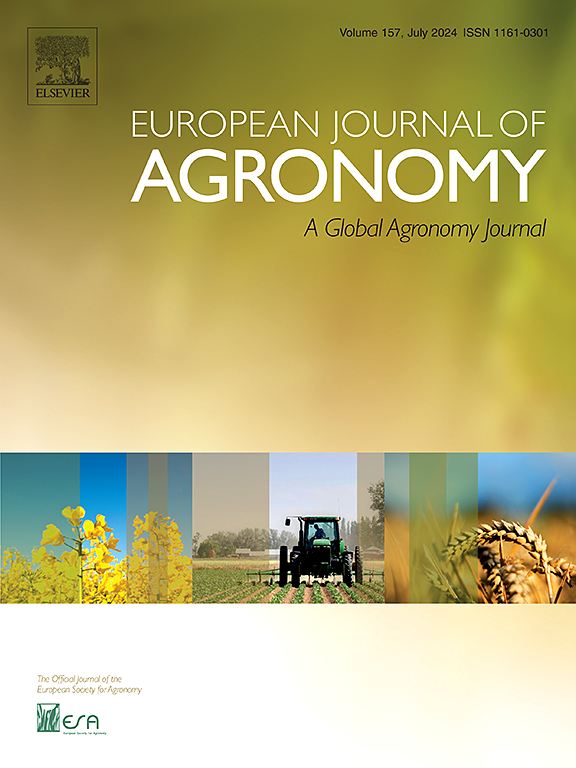对比作物序列的作物和休耕对N2O排放的贡献
IF 5.5
1区 农林科学
Q1 AGRONOMY
引用次数: 0
摘要
南美洲作物序列(CS)的特点是大豆比例高,土壤养分开采问题严重,迫切需要重新配置,以实现更可持续的种植系统。新的CS配置可能会影响一氧化二氮(N2O)的排放。虽然有一些研究在CS水平上进行了报道,但很少对每个序列组成部分(如休耕期或作物)的具体贡献进行彻底分析。目的是:i)在包括所有阶段的长期试验中,量化不同种植强度下不同CS的N2O总排放量;ii)评估N2O排放通量的驱动因素;iii)估计CS各组分对N2O总排放量的贡献。本研究采用大豆(S)、玉米(M)、小麦(W)和大田豌豆(P)组合作物,从单作的S和M到集约化的CS,在2年的时间里进行了4种作物的组合,包括W/S和P/M双作物。在两个季节(2019/20-2020/2021)中,每个月约两次同时测量N-N2O排放量、土壤硝酸盐含量(N-NO3)和充水孔隙空间(WFPS)。在所有CS中,N-N2O排放和N-NO3水平的升高频率都很低。两个季节CS的N- n2o累积排放量平均为881 g ha−1,M-W/S和P/M-W/S高于其他CS,这与它们的配置和N输入无关。我们发现相同CS的不同阶段之间的差异大于CS之间的差异。不同CS及其所处阶段不同,CS各组成部分的贡献也不同。我们没有发现WFPS或N-NO3与N-N2O通量之间的密切联系。在CS水平上获得的年化排放因子处于通常引用值范围的下界,甚至略低。该研究强调了在处理N-N2O测量的研究中包括旋转相的重要性。以提高粮食产量和减少休耕期为重点的战略在尽量减少每单位产量的排放量方面仍然有效。这些办法还促进作物残茬的还田,从而促进收入稳定和土壤健康,有助于环境和经济的可持续性。本文章由计算机程序翻译,如有差异,请以英文原文为准。
Crop and fallow contribution to N2O emissions of contrasting crop sequences
Crop sequences (CS) in South America, characterized by a high proportion of soybean and a concerning soil nutrient mining, urgently require reconfiguration towards more sustainable cropping systems. New configurations of CS may impact nitrous oxide (N2O) emissions. Although reported reported at the CS level in a few studies, the specific contributions of each sequence component, such as fallow periods or crops, have rarely been thoroughly analyzed. The aims were: i) to quantify total N2O emission from different CS with contrasting cropping intensity in a long-term experiment that included all phases, ii) evaluate the drivers of N2O emission fluxes and iii) estimate the contribution of each component of the CS to total N2O emissions. The study was conducted combining crops of soybean (S), maize (M), wheat (W) and field pea (P), from S and M in monoculture to intensified CS with four crops in two years, which included W/S and P/M double crops. We simultaneously measured N-N2O emission, soil nitrate content (N-NO3) and water-filled pore space (WFPS) approximately twice a month during two seasons (2019/20–2020/2021). Low frequencies of elevated values were observed in both N-N2O emissions and N-NO3 levels across all CS. Cumulative N-N2O emissions of CS during two seasons averaged 881 g ha−1, being higher in M-W/S and P/M-W/S, than other CS, not attributable to their configuration nor N inputs. We detected more differences between phases of the same CS than among CS. The contribution of each component of CS was different depending on the CS and their respective phase. We did not find close associations between WFPS or N-NO3 vs N-N2O fluxes. The annualized emission factor obtained at CS level were in the lower bound of the values range usually cited, even slightly lower. The study highlights the importance of including the phase of rotation in studies dealing with N-N2O measurements was reemphasized. Strategies that focus on increasing grain yields and reducing fallow periods remain effective in minimizing emissions per unit of production. These approaches also promote income stability and soil health by facilitating the return of crop residues, contributing to both environmental and economic sustainability.
求助全文
通过发布文献求助,成功后即可免费获取论文全文。
去求助
来源期刊

European Journal of Agronomy
农林科学-农艺学
CiteScore
8.30
自引率
7.70%
发文量
187
审稿时长
4.5 months
期刊介绍:
The European Journal of Agronomy, the official journal of the European Society for Agronomy, publishes original research papers reporting experimental and theoretical contributions to field-based agronomy and crop science. The journal will consider research at the field level for agricultural, horticultural and tree crops, that uses comprehensive and explanatory approaches. The EJA covers the following topics:
crop physiology
crop production and management including irrigation, fertilization and soil management
agroclimatology and modelling
plant-soil relationships
crop quality and post-harvest physiology
farming and cropping systems
agroecosystems and the environment
crop-weed interactions and management
organic farming
horticultural crops
papers from the European Society for Agronomy bi-annual meetings
In determining the suitability of submitted articles for publication, particular scrutiny is placed on the degree of novelty and significance of the research and the extent to which it adds to existing knowledge in agronomy.
 求助内容:
求助内容: 应助结果提醒方式:
应助结果提醒方式:


